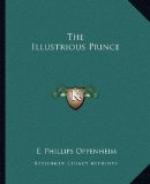“Duke,” he said, “this engraving is a rude thing, but the hand which guided the steel has been withered for two hundred years, and no other example remains of its cunning. Mr. Haviland,” he added, stepping to his writing table, “this lacquered shrine, with its pagoda roof, has been attributed to Kobo-Daishi, and has stood upon the writing table of seven emperors. Sir Edward, this sword, notwithstanding its strange shape and gilded chasing, was wielded with marvellous effect, if history tells the truth, a hundred and thirty years ago by my great-grandfather when he fought his way to the throne. Sir Charles, you are to go into Parliament. Some day you will become a diplomat. Some day, perhaps, you will understand our language. Just now I am afraid,” he concluded, “this will seem to you but a bundle of purple velvet and vellum, but it is really a manuscript of great curiosity which comes from the oldest monastery in Asia, the Monastery of Koya-San.”
He turned to the Duchess.
“Duchess,” he said, “you see that my tapestries have already gone. They left yesterday for Devenham Castle. I hope that you will find a place there where you may hang them. They are a little older than your French ones, and time, as you may remember, has been kind to them. It may interest you to know that they were executed some thirteen hundred and fifty years ago, and are of a design which, alas, we borrowed from the Chinese.”
The Prince paused for a moment. All were trying to express their thanks, but no one was wholly successful. He waved their words gently aside.
“Lady Grace,” he said, turning to the statuette of Buddha in a corner of the room and taking from its neck a string of strange blue stones, “I will not ask you to wear these, for they have adorned the necks of idols for many centuries, but if you will keep them for my sake, they may remind you sometimes of the color of our skies.”
Once more he went to his writing table. From it he lifted, almost reverently, a small bronze figure,—the figure of a woman, strongly built, almost squat, without grace, whose eyes and head and arms reached upwards.
“Miss Penelope,” he said, “to you I make my one worthless offering. This statuette has no grace, no shapeliness, according to the canons of your wonderful Western art. Yet for five generations of my family it has been the symbol of our lives. We are not idol worshippers in Japan, yet one by one the men of my race have bent their knee before this figure and have left their homes to fight for the thing which she represents. She is not beautiful, she does not stand for the joys and the great gifts of life, but she represents the country which to us stands side by side with our God, our parents, and our Emperor. Nothing in life has been dearer to me than this, Miss Penelope. To no other person would I part with it.”




